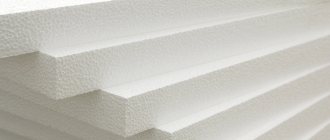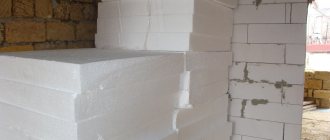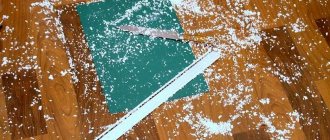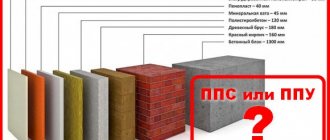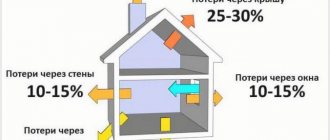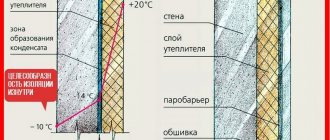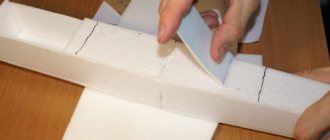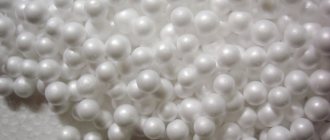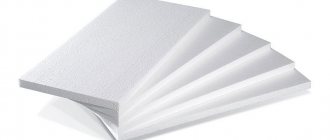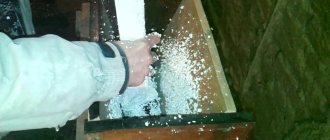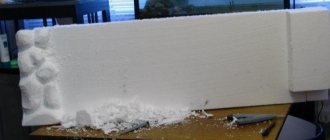Main characteristics
- thermal conductivity is low (the extruder has the same thermal conductivity as other types of polystyrene foam, but the extruder is more expensive)
- durability (up to 60 years does not lose properties when the temperature changes from -40 to +40 °C throughout the year)
- moisture resistance
- it does not create an environment favorable for the development of mold and similar “life” (can only occur on the joint surface of, for example, wood)
- minimal harmfulness (it is allowed to be used in the food industry (packaging));
- a light weight
- noise insulation (3 cm thickness reduces noise up to 25 dB)
- fire resistance (we can only talk about it when it comes to fire-resistant varieties; you also need to know that in the production of fire-resistant types, a larger amount of carbon dioxide is used and if the combustion process takes place directly, then the release of this gas will be greater and it will burn, although the temperature it has a high temperature of +490 °C)
- vapor permeability (similar to wood such as oak)
- tensile strength is at least 20 MPa
- resistance to alcohols and ethers, but is easily destroyed when exposed to solvents
- does not withstand ultraviolet radiation (when using slabs, they must be covered with a protective layer of primer and painted)
Expanded polystyrene is mistakenly called polystyrene foam in everyday life. Let's look at the main differences between the characteristics:
- absorbs water and vapor
- visually they can be distinguished (it has a uniform structure, and the foam has large granules)
- density higher than foam
- mechanical strength
Advantages
If all installation rules are followed, liquid foam will last more than 50 years without defects. Other arguments in favor of insulation such as Liquid Penoplast:
- Fire safety;
- adhesion (bonds, connection) with solid materials (concrete, stone);
- natural composition, safe for human health;
- fire resistance;
- reasonable price;
- wide range of permissible temperatures;
- static dimensions, no swelling after hardening;
- low consumption over large areas;
- minimizing the risk of surface damage by microorganisms or insects.
The material does not require preliminary thorough preparation of the surface, which significantly reduces time and money costs. To apply foam with your own hands, you will need a hose (diameter of at least 30 mm). With its help, the substance reaches the most inaccessible places. Insulation using the “old-fashioned” method (using foam rubber) has long since sunk into oblivion due to its ineffectiveness.
Interesting fact: the quality indicators of vapor permeability make it possible to successfully use liquid foam to protect wood coverings, walls, and facades.
Interesting things about polystyrene foam
The American Alliance of Recyclers conducted research in 2004. The goal was to find out whether mold can grow on foamed plastics. Expanded polystyrene was taken as a sample. Pieces of material were placed underground, at a distance of 20 cm from groundwater. According to the results of the experiment, it turned out that neither mold nor fungi are adapted to life in such conditions. Even those blocks that were completely immersed in water were only 4% saturated with it. This is the best indicator for moisture resistance of building materials.
Polystyrene is widely used in everyday life. But the negative qualities of the material affect the environment. Disposing of polystyrene foam at home is dangerous to health and life. You can ensure proper disposal by contacting a waste recycling company.
Waste foam made from polystyrene belongs to class 5 in terms of hazard level, according to FKKO. It follows from this that the disposal of this material does not require a special passport . However, recycling foam requires special attention. Since products made from this substance do not decompose in nature, soot and carbon monoxide are released during simple combustion or pyrolysis. This is unsafe for the environment and people.
Characteristics and properties
Expanded polystyrene is designed to retain heat. This happens due to compressed small balls containing air. They form a solid air cushion, similar to foam, which is why the material has a similar name.
The density of the material ranges from 0.028 to 0.034 watt meter per Kelvin. The indicator depends on weather conditions. Scientists proved in 2014 that mold fungi are not able to live on this insulation.
Each type has its own vapor conductivity. For example, extruded does not allow steam to pass through at all, but foamed - from 0.019 to 0.015 kg per m/h/Pascal. The difference appears due to the fact that the second type is obtained by cutting from a whole block into slabs of the required thickness. Therefore, air penetrates through the broken structure of the balls.
Moisture absorption works on the same principle as vapor barrier. Solid polystyrene foam will absorb a maximum of 0.4 percent of water, thinner ones can absorb ten times more - 4%. Due to its dense structure, extruded is considered strong, approximately 0.4 to 1 kg per square cm.
Due to the presence of antiperspirants in the composition, polystyrene foam will last for many years without losing its advantages. Based on all of the listed properties, solid polystyrene foam is significantly better than foamed polystyrene. He almost ousted his competitor from the market and became the most popular.
What is polystyrene foam or expanded polystyrene?
First you need to understand what polystyrene foam is and how it behaves under various influences. And understand whether polystyrene foam is harmful to health?
Expanded polystyrene is a gas-filled material. They are made by steam heating polystyrene granules. These granules are first filled with gas. The gas used is different: in ordinary polystyrene foam, natural gas is used, in fire-resistant foam, carbon dioxide is used. When heated, the gas expands, and the granules increase many times in size (15 - 30 times the original).
If nothing restrains the expansion of granules, then the result is a crumbly material that is used in filling frameless furniture, packaging, and construction. To obtain solid forms of polystyrene foam, foaming is carried out in a closed form of the desired configuration. This is how flat sheets of insulation, embossed decorative products, boxes for packaging household appliances and much more are obtained.
The resulting material has a number of very advantageous qualities:
- high thermal insulation;
- high durability;
- low water absorption;
- low vapor absorption;
- biological stability;
- unattractive to rodents and parasites.
Polyfoam is an inexpensive, very light, practically non-moisture-absorbing material with low thermal conductivity. It is resistant to rot and biocontamination, durable, can take any shape and be elastic, but hard enough to hold its shape.
Thanks to this, expanded polystyrene has become widely used in many areas:
- In ammunition for safety (both military and civilian). In helmets, knee pads, and elbow pads, polystyrene foam is used as a shock-absorbing material and insulation.
- For the production of disposable tableware. Containers for hot food and cups for drinks are widely used.
- As packaging material. Expanded polystyrene protects fragile items well during transportation. It can be used both in bulk and in the form of pressed forms of the desired profile.
- For the manufacture of children's toys and child safety products.
- For frameless furniture (poufs, bean bag chairs).
- When making blanks for handicrafts and creativity.
- For the manufacture of decorative elements of the interior and garden decoration (fake stones, garden figures)
- In some countries (Japan, Finland, Norway, Canada, USA), polystyrene foam is used in road work to protect soil from freezing, reduce the vertical load on soils prone to subsidence, create artificial unevenness, etc. In Russia, polystyrene foam is not used for this purpose .
- For interior and exterior finishing. Various decorative elements of facades, ceiling tiles, imitation stucco molding and much more are made from expanded polystyrene.
- In the production of polystyrene foam, concrete and polystyrene foam blocks for the construction of walls in low-rise construction.
- For the manufacture of various heat-insulating and sound-insulating materials.
We advise you to study - Socket connection diagram
Polystyrene foam packaging
What exactly do they hand over and what requirements do the acceptors have?
For reference, foam comes in a number of different forms that are used in different ways in practice. At the same time, the disposal of such waste has significant differences. Common types include:
- heat and sound insulators (although the admissibility of this fact is controversial among builders);
- disposable tableware (not excluding coffee cups, coolers);
- egg trays;
- floats, elements of life jackets;
- packaging material for transportation;
- products marked with a Mobius loop with a “6” inside.
More examples of foam plastic waste that are most often bought up: Production waste: cutting, sprues, defective products, surplus stock, fish boxes, office equipment boxes, polystyrene foam packaging, foam plastic waste from the dismantling of cars, ships and refrigerators, compacted foam plastic, pressed, the insides of household refrigerators , washing machine bodies, disposable polystyrene foam tableware, waste interior and picture frames, etc.
Regular waste collection points are in no hurry to accept these products. The reason is clear, the density of the material. It takes up large areas for collection, and it is necessary to provide protection from moisture. Since only dry and cleaned foam is accepted for processing. Contaminants include various types of labels, stickers, including tape, etc.
In addition, all listed products are sorted into groups and are disposed of separately. For example, insulation and insulation materials made from polystyrene foam easily dissolve in benzene and acetone, resulting in adhesive. Carrying out a similar process at home is quite simple and safe. It is enough to fill a jar or glass flask with acetone only a quarter full. After this, the plates are broken or cut with a sharp knife into pieces that can fit inside the jar. Dissolution occurs quite actively and reminds many of a chemistry lab. They also add crumbs, which inevitably happen. When the substance in the jar thickens, they talk about the formation of glue - in this way you can dispose of polystyrene foam at home, see the video below (the video, although humorous, is clear - the foam easily and quickly dissolves in acetone):
Foams are not subject to decomposition in alcohol or other liquids. To burn polystyrene foam, it is necessary to create special conditions under which the material decomposes into water and carbon. The temperature required for this process cannot be achieved in domestic conditions.
Styrofoam scraps, what type of waste should they be classified as? They also belong to solid waste and are qualified with code 43414101205 and require disposal in accordance with general standards. There are companies interested in using waste foam, the use of which extends to the manufacture of the following:
- polystyrene concrete;
- furniture, toys (crushed material, its non-toxic types, are in demand in production);
- insulation;
- foam blocks;
- foam sheets
- new foam blocks by adding crushed foam during cooking.
Using polystyrene foam as insulation
It is furniture makers, builders and manufacturers of toys, small products for fishermen, who often become the authors of requests: where to buy waste foam plastic. Meanwhile, this is exactly the case when you can begin to independently collect this type of waste on a paid or not basis.
Video - special equipment for processing polystyrene foam into granulate
The influence of polystyrene foam on human health
Questions about whether polystyrene foam is harmful to health or not have worried consumers almost from the very beginning of its use. Each new finishing and building material based on foam plastic caused a renewal of these disputes.
Proponents of the use of expanded polystyrene cite the research of scientists - chemists, physicists and materials scientists - as a safety argument. Expanded polystyrene, without external influences on it, practically does not interact with the environment.
Its molecular structure is very stable. The experiments described above show that under normal human conditions, polystyrene foam does not emit any harmful substances. Actually, it does not release any substances.
Might be interesting
Opponents of the use of expanded polystyrene claim the possibility of styrene release. Even if not under ordinary, but under extreme conditions. Extreme conditions refer to exposure to high temperatures. Indeed, when burned, polystyrene foam, like many other substances, releases a large amount of toxic substances, among which styrene is considered especially toxic.
Effect of styrene on humans:
- dizziness;
- irritation of the mucous membranes of the eyes;
- high concentrations lead to lung damage and even fatal poisoning;
- the functioning of the kidneys, liver, and hematopoietic system is disrupted;
- oncology.
The flammability of the initially created polystyrene foam was quite high. At temperatures above 210 °C, the foam was able to independently support surface combustion and spread fire. That is why fire retardants (substances that inhibit ignition and flame spread) are now used for the production of construction and finishing polystyrene foam.
Thanks to this, it was possible to reduce flammability and increase the ignition temperature to 440 °C. In addition, most modern polystyrene foam products do not allow flames to spread and do not support spontaneous combustion.
It must be said that, like many other substances that are dangerous in large doses, but harmless in small doses, styrene is naturally found in many products that we use every day - coffee, tea, cinnamon, cheese, strawberries and so on.
Melting polystyrene foam
The harm of expanded polystyrene to human health may also be associated not so much with the qualities of the material, but with its improper use in finishing. Expanded polystyrene is a very popular thermal insulator, but at the same time it does not allow steam and moisture to pass through. It happens that people, out of ignorance or out of economy, insulate the walls between the apartment and the street from the inside with sheets of expanded polystyrene.
This situation is serious because the moisture in the warm home air collides with the cold wall directly under the foam and condenses there. The wall on the concrete surface is constantly wet, which will inevitably lead to the development of fungus and black mold, the spores of which are a dangerous allergen. Black mold can trigger the development of asthma, chronic bronchitis and other diseases.
Where to put pieces of foam plastic (how to get rid of them)
Since large volumes are needed to dispose of polystyrene waste, ordinary citizens throw it in the trash. To prevent the dangerous consequences of the accumulation of harmful substances in a landfill, you can use one of the following techniques.
Method 1: How to Recycle Styrofoam
The method is to find a place to collect PS. These are businesses that display special containers, own websites on the topic, or accept products by mail. There are no such organizations in Russia yet, but it is possible to negotiate postal deliveries with foreign manufacturers. But there are institutions where you can take small amounts of polystyrene foam for recycling.
You can open your own collection point. This will require time and negotiation skills. The positive side of the coin is caring for the environment and meeting new people.
Method 2: Foam Alternatives
The substitutes are:
- foil;
- cardboard and paper;
- packaging materials based on soy and mushrooms.
These products are degradable or burn without releasing hazardous substances. They can replace those wrappers and seals based on polystyrene. Humanity has not yet come up with an alternative to construction raw materials.
Method 3: Reuse Styrofoam
In everyday life, the material is useful for the following purposes:
- Filling the insides of furniture. If the filling in a chair has become unusable, you can replace it with polystyrene foam.
- Making floats - polystyrene floats perfectly on the water.
- Creating crafts for children, decorative elements for the garden and home.
- Preparation of glue. To do this, you need to dissolve the waste in acetone. The chemical reaction itself is of interest. Suitable for gluing crafts, but nothing more.
With careful research, you can find an option on how you can use polystyrene waste in the household and for the development of imagination. But you shouldn’t insulate a house with used material. This is caused by the flammability of the raw material and loss of properties after use.
What to choose for the balcony: polystyrene foam or other materials?
- Styrofoam. The most popular material for insulating loggias and balconies. It differs from others in its availability, good technical characteristics and low cost. Also, it is easy to install.
- Penofol. It is often used as a vapor and waterproofing material and a base for thermal insulation. It is a layer of foamed polyethylene, which is covered with foil on one or both sides. It is lightweight and thin, and is available in rolls.
- Extruded polystyrene foam (Penoplex). It is an orange-colored slab that has a low thermal conductivity coefficient and a long service life (up to 40 years). Tolerates high humidity well. It has higher strength and cost compared to other materials.
- Mineral wool. It is as widespread as polystyrene foam. It has good technical characteristics, is resistant to fire and is of natural origin. However, when insulating a balcony and other building elements, it requires high-quality vapor and waterproofing.
If you need high-quality insulation of a loggia or balcony, and there are no plans to spend large sums of money, then using polystyrene foam is the best option.
Foam waste, disposal and recycling
Polystyrene production technologies make it possible to enrich it with gas. The materials belong to a large group of foamed plastics. Recycling foam plastic and destroying it according to the rules is no different from recycling polystyrene. In practice, they are burned with the rest of the garbage in a landfill.
- small particles falling off during the production of children's and household goods;
- used products;
- debris during installation of slabs.
Foamed plastics are lightweight, which makes it easier to install tile products during construction. Used to make jewelry, toys, packaging, and marketing products.
Types of foam
Divided into the following types:
- polystyrene;
- polyethylene;
- polyvinyl chloride;
- polyurethane.
Polystyrene
There are two ways to produce this type of foam:
Pressless. This variety is familiar to every person
When buying home appliances, you can pay attention to the fact that they are packaged in foam plastic, consisting of small balls fastened together. It is very fragile and can be crushed and broken by hand.
Press
But this type will be much more difficult to crumble. The granules of such foam are more tightly bonded to each other. The production technology is much more complex and more expensive than that of the non-press type, so it is much less common.
There is such a variety as extruded foam; it is practically no different from non-pressed foam.
Polystyrene types of foam have one significant disadvantage - high hygroscopicity.
Water vapor enters the cavities that are located between the “balls” and granules.
This material “does not breathe”, so the steam does not escape anywhere and when exposed to sub-zero temperatures it can freeze, destroying the structure.
Even in the absence of exposure to cold, the accumulated steam worsens the thermal insulation properties of the foam and increases the humidity in the room.
We advise you to study - Methods of soundproofing walls in an apartment with modern materials
Extruded foam plastic does not have such disadvantages, since it is homogeneous in its structure. It is common in the production of disposable cutlery, tableware, and food packaging.
As for the durability of polystyrene foam, we can say that for non-pressed foam it will range from 10 to 35 years. Extrusion will last much longer, about 50-70 years. Of course, the service life directly depends on the manufacturer of the material and the impact of destructive factors at the installation site.
Polyurethane
One example of polyurethane foam is foam rubber. It has a porous structure, good air and steam permeability, and high elasticity. It is used in furniture production, both as upholstery and as a filler.
Based on it, many household items are made. It is highly flammable and releases hazardous substances that are more toxic than polystyrene foams. The reason for this is hydrocyanic acid in the composition. It is extremely short-lived, turns yellow and is destroyed when exposed to external factors such as ultraviolet radiation.
Polyvinyl chloride
Polyvinyl chloride itself is a thermoplastic polymer that contains up to 56.8% bound chlorine, which makes it difficult to burn. It can be produced using both press and non-press methods. Its properties are similar to extruded polyethylene foam.
It contains no toxic substances. When burning, polyvinyl chloride foam extinguishes on its own.
It is highly elastic, but can corrode metal structures next to which it is located.
Polyethylene
It occurs quite often in everyday life. It looks like a translucent film consisting of air pimples.
It is used for wrapping fragile items and easily damaged equipment and does an excellent job of protecting against damage.
Polyethylene foam is very elastic and has different thicknesses, from a few millimeters to several centimeters. It is similar in strength to extruded polystyrene foam, but its distinctive feature is its non-toxicity. It is considered an environmentally friendly material with a long service life. Flammable.
Video description
Since not all manufacturers indicate this parameter, you need to be able to determine it yourself. How to do this is shown in the video:
The quality of products also varies and depends on the manufacturer’s compliance with manufacturing technology. Some introduce harmful additives into raw materials or do not use recommended components. Sometimes ordinary polystyrene foam is sold under the guise of EPS. To be sure of quality, you should buy certified products manufactured not according to the manufacturer’s technical specifications, but according to GOST.
Advice! You can verify good quality by performing a simple test. You need to break off a piece of material and inspect the fracture site - small regular polyhedra should be visible on it, not balls.
Depending on the place of application, choose slabs with a stepped edge or a corrugated surface, which facilitates the application of a plaster layer on it.
Advantages and disadvantages
Now it’s worth considering what the advantages of one and the other materials are. After all, each of them was invented for a reason and is in demand among consumers.
Styrofoam
The main positive qualities of polystyrene foam include:
- Using it as wall insulation both inside and outside the building.
- Its relatively low price is why it is in demand among consumers.
- The material is quite moisture resistant.
- Has little weight.
- Easy to use and install. In addition, it is easy to cut using a knife or other cutting object.
- Good insulation for foundations.
- Polystyrene foam can be cut at various angles, and any shapes can be cut out of it.
- The material can be painted and plastered.
Polystyrene foam is a good insulation material for foundations.
The disadvantages of the material include:
- The thickness of the material used should not exceed 3 cm.
- To better attach the material to the wall, it must be perforated, for example, with a needle roller.
- It is necessary to take care of the fireproof coating for the material.
- When installing foam sheets, it must be completely coated with glue.
- When leveling the sheet, it is necessary to use a moisture-proof putty.
It can be seen that the material has both positive and negative sides. Therefore, before purchasing, you need to weigh the pros and cons so as not to get into trouble.
Expanded polystyrene
Its main advantages are:
- It does not transmit heat well, meaning it remains indoors.
- It does not allow moisture to pass through well, which means that even if the material is exposed to rain for several hours, it will remain dry.
- Despite its artificial origin, it allows the house or any other structure to breathe.
- Not subject to rotting.
- Not affected by fungus.
- Durable. Can last about 50 years.
- The material is good to use as a sound insulator. Because it has a homogeneous structure that muffles and absorbs sounds.
The disadvantages of this material include:
- Price. This material is not the cheapest. This is why many consumers buy polystyrene foam.
- This material is destroyed under the influence of certain solvents.
- Expanded polystyrene is susceptible to destruction by rodents. It is quite easy for them to build passages and houses in the material.
- Just like polystyrene foam, polystyrene foam is a flammable material. Therefore, it is necessary to take care of safety. Cover it with a special solution.
It can be seen that the positive aspects of expanded polystyrene are quite attractive, in some cases even better than those of polystyrene foam. However, the main and sometimes decisive disadvantage is the high price of the material.
What can be made from leftover packaging foam?
If you have a lot of free time on the weekend, it's worth doing something new. For example, you can try to surprise your loved ones with useful crafts from scrap materials.
Polystyrene foam is still a common packaging material. When buying household appliances, dishes or other household items, we often throw the packaging in the trash. Meanwhile, there may be a better use for it. This statement is especially true for polystyrene foam, which is very poorly disposed of because it does not decompose and releases harmful substances when burned. Using polystyrene foam at home, you will simultaneously improve your life by making, for example, garden figures from polystyrene foam, and thereby protect nature from pollution.
Insulation of windows and rooms
Polystyrene foam is an excellent material for insulating windows and rooms of a country house. It keeps the cold out and maintains the internal temperature in the rooms. Instead of specifically buying sheets of foam plastic in construction hypermarkets, you can use what you already have, which was left over after purchasing home appliances.
To insulate the windows of a country house, it is necessary to cut the foam into strips so that their width is slightly larger than the width of the window slits. After this, you need to hammer the chopped material into the cracks. When insulating walls, larger pieces are usually used, on top of which siding or eurolining is mounted.
Among the undeniable advantages of polystyrene foam, it is worth noting its resistance to fungi and harmful microorganisms. The material is also practically impermeable to moisture.
Flower garden arrangement
If you want to increase the breathability of the soil, you can also use polystyrene foam for this. Professional gardeners recommend it instead of special products such as vermiculite and perlite. To prepare the material for use, you need to grate it. In order to prevent the possibility of an electrostatic effect, it is advisable to thoroughly moisten the foam with water in advance. Then the resulting crumbs must be thoroughly mixed with the ground. This soil breathes well and is excellent for arranging a flower garden.
Toy for children
If you have children, then they will certainly be delighted with the wonderful construction set that can be made from foam plastic packaging. You need to cut the foam into even geometric shapes. Now you can use tape to make various fun toys from them.
Foam is also good for modeling. You can make sailing boats out of it, then launch them with your children in the bathtub or pond.
PARTNER NEWS
Related news
- Clean and healthy skin at home. Useful tips for your beauty
- How to choose a laptop backpack: what to look for
- An expert explains how to properly care for your washing machine.
How do foam products affect the environment?
Of course, such a proliferation of material and its daily participation in human life makes one wonder: is polystyrene foam harmful or safe?
Manufacturers declare that one of the most important performance qualities that polystyrene foam possesses is environmental friendliness. But their interest is quite understandable. That is why, when determining whether polystyrene foam actually harms the environment, it is better to turn to scientific research.
Expanded polystyrene under a microscope
The environmental friendliness of any material is determined by its own impact on the environment, the impact under certain conditions and when interacting with other substances.
Moreover, it is necessary to consider both the immediate impact and the long-term one. Here are the main influencing factors:
- Expanded polystyrene practically does not absorb water and does not interact with it at all. Therefore, its use, for example, in finishing and insulating facades, is not only effective, but also safe. It follows from this that ceiling tiles made of foam plastic, if not heated, pose no harm.
- Expanded polystyrene does not oxidize when exposed to air and does not decompose when exposed to ultraviolet radiation. These qualities allow polystyrene foam to be disposed of in a household waste dump, rather than at a specialized chemical site.
- Expanded polystyrene is not dissolved by any substances that it might come into contact with in a household waste dump. Solvents for it are acetone, original styrene, aromatic and chlorinated hydrocarbons. These substances are not (or at least should not be) found in household waste dumps.
- Expanded polystyrene is a very durable material. Cyclic stability tests with annual temperature changes in the range from -40 ° C to +40 ° C with exposure of the material to ultraviolet radiation and water showed that even after 80 cycles (which corresponds to 80 years), the structure of polystyrene foam remained unchanged.
- Temperature extremes are not typical for polystyrene foam use conditions, but have also been studied. When heated without an open flame source, even polystyrene foam not treated with fire-fighting substances begins to collapse only at 300 °C, and with an open flame - at 210 °C. The impact of low temperatures can not be taken into account at all, since destruction occurs only superficially, and even then at -310 °C.
We advise you to study - Decorating the walls of the living room: modern and beautiful ideas
Unfortunately, the bulk of used polystyrene foam is disposed of in household waste landfills. When buried, polystyrene foam is practically harmless to the environment, since it does not interact with water and air, but it does not decompose.
The situation is complicated by the fact that the collection and processing of polystyrene foam is not economically profitable today. During processing, expanded polystyrene can be used to produce polystyrene, however, the cost of this process is comparable to the production of polystyrene from primary raw materials, but requires a more complex organization of the process.
Another way to process expanded polystyrene is to grind it for use in the production of concrete - expanded polystyrene blocks, filler for heat-insulating mixtures and similar materials. This is a promising area of recycling that offers hope for reducing landfills.
Pile of old foam plastic
It is too early to say what harm polystyrene actually causes or will cause to the environment. The material is very durable. Even the first mass-produced foam plastics, buried in landfills long ago, have not yet approached the threshold of decomposition.
Recycling and disposal of polystyrene foam
This is a PS copolymer, which is actively used in construction. It performs the function of heat and sound insulation of walls, floors, and ceilings. Waste is generated during the installation of slabs. To produce recyclable materials, used products and scraps are crushed into crumbs for subsequent addition to concrete.
The difficulty of processing expanded polystyrene lies in its large volumes and low mass. 98% of the material is air. The process of enrichment and destruction itself is identical to that described above.
Why recycle polystyrene foam?
Throwing used items into a landfill is a great way to dispose of household waste. But this inorganic material pollutes the Earth. It has been established that for 80 years at temperatures from -40 to +40 0 C it does not decompose. This means that polystyrene in general and plastics in particular:
- resistant to air and ultraviolet radiation;
- react with certain chemical elements.
Disposal of polystyrene foam using nitric acid is impossible, since PS is not affected by it. Styrene, acetone, benzene, chloride and aromatic hydrocarbons are polystyrene solvents. But the rules provide for special disposal for these substances, so they are not in the landfill.
Combustion of polystyrene provokes the release of harmful substances into the atmosphere: hydrocyanic acid, soot, carbon monoxide and carbon dioxide, hydrogen bromide, phosgene. Oversaturation with them is fatal for humans and animals, and nature suffers.
In fires, people often die not from fire, but from poisoning. Throwing away polystyrene along with household waste or burning it means causing harm to the environment and its inhabitants.
Where to recycle polystyrene foam
Enterprises in European countries and the USA are actively engaged in the manufacture of products from polystyrene and its derivatives. In Russia, interest in polystyrene foam recycling and disposal has been growing in recent years. But this is done by individuals and enterprises who are not indifferent to the state of the environment. Commercial interest is weak for a number of reasons:
- Polystyrene foam as a recyclable material is cheap, but it is difficult to find a consumer. It is necessary to organize waste collection, pay for the work of collectors, and due to the low price of the final product, this is difficult to do.
- The low density of waste raises questions about storage. Due to the large dimensions and low weight, volumetric areas are required.
- Requirements for the room: it must be dry. This is not always possible during periods of rain and frost.
The use of foam plastic for thermal insulation
Wall insulation
Polystyrene foam is widely used as insulation for external walls, and even owners of city apartments have begun to do this in the face of significant increases in energy prices.
The polystyrene foam is screwed to the facade of the building with dowels, then plastered, after laying a metal mesh on top of it.
Another common option is:
- Polystyrene foam is laid in the spaces between the sheathing bars, the cross-section of which corresponds to the thickness of the slabs
- Siding panels are attached to the sheathing with seams sealed with foam
Polystyrene foam is also widely used as insulation for walls inside an apartment.
Insulation of basements and plinths
When insulating basements, foundations and plinths with foam plastic, the low strength of this heat insulator should be taken into account. In winter, it will experience significant loads from freezing soil, which, if unprotected, will lead to its deformation or destruction. For this reason, a brick or concrete lining is constructed outside the thermal insulation layer of foam plastic.
Floor insulation
The environmental friendliness of polystyrene foam has led to its widespread use inside buildings. For example, it is often used as a thermal insulator in floor construction. The polystyrene foam is laid on top of the waterproofing layer, filling the seams with polyurethane foam or silicone sealant. Then a screed and a finished floor covering are laid on top of the slabs.
Methods of roof insulation
Thermal insulation of roofs using foam plastic is carried out using one of two technologies:
- Installation of a non-ventilated (warm) roof. With this method, the roof is covered with 70 mm thick foam plastic slabs, which are then filled with bitumen
- Installation of a ventilated (cold) roof. In this case, the foam is attached to the inside of the roofing so that there is a ventilated gap through which water vapor will be removed
Is foam plastic harmful as insulation?
A significant disadvantage of polystyrene foam is the high danger it poses in the event of a fire. Manufacturers and marketers position this material as non-flammable and point to its ability to self-extinguish, which is especially evident in the presence of a fire retardant additive. However, a material does not have to ignite to be dangerous in a fire.
As experience and numerous tests have shown, exposure to flame and high temperatures provokes thermal decomposition processes in foam plastic, as a result of which the air, even at a considerable distance from the fire site, is filled with a large amount of smoke, corresponding in toxicity to substances of the highest hazard class.
There are a large number of insulation materials for the home. If foam is not your thing, then you may want to consider other options. For example, Rockwool insulation, the technical characteristics of which make it possible to perfectly protect the house from heat loss. The structure of the material allows the walls to “breathe”, therefore, there will be no problems with rotting and fungus formation.
Rockwool insulation is essentially mineral wool. If you only need to insulate the ceiling, we recommend that you familiarize yourself with the process of insulating the ceiling with mineral wool here. You can install this material yourself.
Price
Here is the approximate price for polystyrene foam as insulation of various brands:
- PSB-S-15O (density - about 9 kg/cubic m): 1050 rub.
- PSB-S-25 (about 15 kg/cubic m): 1800 rub.
- PSB-S-25T (about 20 kg/cubic m): 2350 rub.
- PSB-S-35 Light (density - from 21 to 23 kg/cubic m): 2550 rub.
- PSB-S-35T (density - from 26 to 28 kg/cubic m): 3050 rub.
Users unanimously recognize the affordable price as the most important advantage of polystyrene foam. Forum participants rate the thermal insulation qualities of polystyrene foam quite highly.
But owners of private houses advise using this insulation only where there are no problems with mice. One of the users said that in the polystyrene foam he used to insulate the garage, these rodents made a whole system of passages, and their activity is accompanied by clearly audible sounds.
